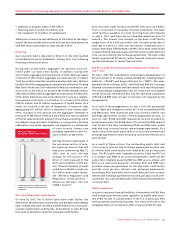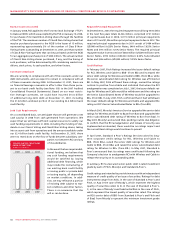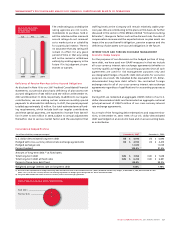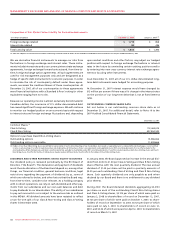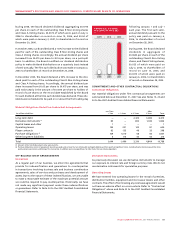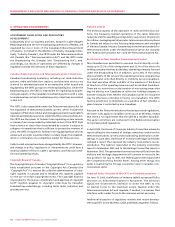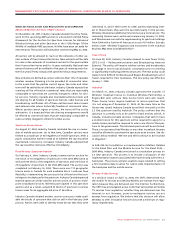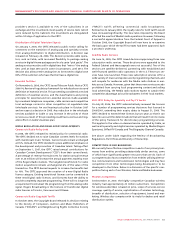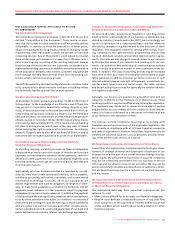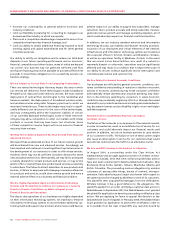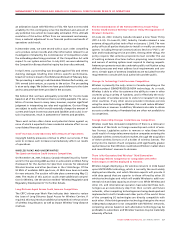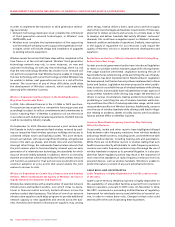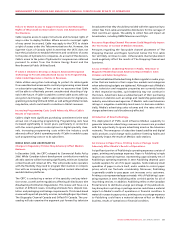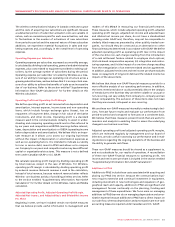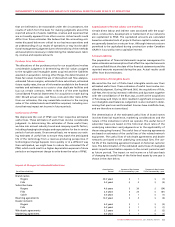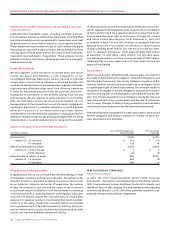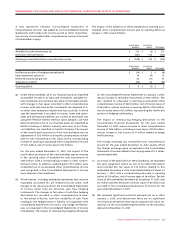Rogers 2007 Annual Report Download - page 59
Download and view the complete annual report
Please find page 59 of the 2007 Rogers annual report below. You can navigate through the pages in the report by either clicking on the pages listed below, or by using the keyword search tool below to find specific information within the annual report.
ROGERS COMMUNICATIONS INC. 2007 ANNUAL REPORT 55
MANAGEMENT’S DISCUSSION AND ANALYSIS OF FINANCIAL CONDITION AND RESULTS OF OPERATIONS
RISKS AND UNCERTAINTIES APPLIC ABLE TO RC I AND
ITS SUBSIDIARIES
We Face Substantial Competition.
The competition facing our businesses is described in the section
entitled “Competition In Our Businesses”. There can be no assur-
ance that our current or future competitors will not provide services
comparable or superior to those we provide, or at lower prices,
adapt more quickly to evolving industry trends or changing market
requirements, enter the market in which we operate, or introduce
competing services. Any of these factors could reduce our market
share or decrease our revenue or increase churn. Wireless antici-
pates some ongoing re-pricing of the existing subscriber base as
lower pricing offered to attract new customers is extended to or
requested by existing customers. In addition, as wireless penetration
of the population deepens, new wireless customers may generate
lower average monthly revenues than those from its existing cus-
tomers, which could slow revenue growth.
The CRTC Broadcasting Distribution Regulations do not allow Cable
or its competitors to obtain exclusive contracts in buildings where
it is technically feasible to install two or more systems.
We Are Controlled by One Shareholder.
At December 31, 2007, we had outstanding 112,462,014 RCI Class A
Voting shares. To the knowledge of our Directors and Officers, the
only person or corporation beneficially owning, directly or indi-
rectly, or exercising control or direction over more than 10% of our
outstanding voting shares is Edward S. Rogers, our President and
CEO, and a Director. As of December 31, 2007, Edward S. Rogers ben-
eficially owned or controlled 102,232,198 RCI Class A Voting shares,
representing approximately 90.9% of the issued and outstanding
RCI Class A Voting shares, which class is the only class of issued
shares carrying the right to vote in all circumstances. Accordingly,
Edward S. Rogers is able to elect all of our Board of Directors and to
control the vote on matters submitted to a vote of our shareholders.
Our Holding Company Structure May Limit Our Ability to
Meet Our Financial Obligations.
As a holding company, our ability to meet our financial obligations
is dependent primarily upon the receipt of interest and principal
payments on intercompany advances, rental payments, cash divi-
dends and other payments from our subsidiaries together with
proceeds raised by us through the issuance of equity and debt and
from the sale of assets.
Substantially all of our business activities are operated by our sub-
sidiaries, other than certain centralized functions, such as payables,
remittance processing, call centres, real estate, and certain shared
information technology functions. All of our subsidiaries are
distinct legal entities and have no obligation, contingent or other-
wise, to make funds available to us whether by dividends, interest
payments, loans, advances or other payments, subject to payment
arrangements on intercompany advances. In addition, the payment
of dividends and the making of loans, advances and other payments
to us by these subsidiaries are subject to statutory or contractual
restrictions, are contingent upon the earnings of those subsidiaries
and are subject to various business and other considerations.
Certain subsidiaries provide unsecured guarantees of our bank and
public debt and cross-currency interest rate exchange agreements.
Changes in Government Regulations Could Adversely Affect Our
Results of Operations in Wireless, Cable and Media.
As described under Government Regulation and Regulatory
Developments, substantially all of our business activities are reg-
ulated by Industry Canada and/or the CRTC, and accordingly our
results of operations on a consolidated basis could be adversely
affected by changes in regulations and by the decisions of these
regulators. This regulation relates to, among other things, licenc-
ing, competition, the cable television programming services that
we must distribute, wireless and wireline interconnection agree-
ments, the rates we may charge to provide access to our network
by third parties, resale of our networks and roaming on to our net-
works, our operation and ownership of communications systems
and our ability to acquire an interest in other communications sys-
tems. In addition, the costs of providing services may be increased
from time-to-time as a result of compliance with industry or legis-
lative initiatives to address consumer protection concerns or such
Internet-related issues as copyright infringement, unsolicited com-
mercial e-mail, cyber-crime and lawful access. Our cable, wireless
and broadcasting licences may not generally be transferred with-
out regulatory approval.
Generally, our licences are granted for a specified term and are
subject to conditions on the maintenance of these licences. These
licencing conditions may be modified at any time by the regulators.
The regulators may decide not to renew a licence when it expires
and any failure by us to comply with the conditions on the mainte-
nance of a licence could result in a revocation or forfeiture of any
of our licences or the imposition of fines.
The licences include conditions requiring us to comply with
Canadian ownership restrictions of the applicable legislation. We
are currently in compliance with all of these Canadian ownership
and control requirements. However, were these requirements to be
violated, we would be subject to various penalties, possibly includ-
ing, in the extreme case, the loss of a licence.
We May Engage in Unsuccessful Acquisitions or Divestitures.
Acquisitions of complementary businesses and technologies, devel-
opment of strategic alliances and divestitures of portions of our
business are an active part of our overall business strategy. Services,
technologies, key personnel or businesses of acquired companies
may not be effectively assimilated into our business or service
offerings and our alliances may not be successful. We may not be
able to successfully complete any divestitures on satisfactory terms,
if at all. Divestitures may result in a reduction in our total revenues
and net income.
We Have Substantial Debt and Interest Payment Requirements
that May Restrict our Future Operations and Impair our Ability
to Meet our Financial Obligations.
Our substantial debt may have important consequences. For
instance, it could:
• Makeitmoredifcultforustosatisfyournancialobligations;
• Requireustodedicate asubstantial portionofany cashow
from operations to the payment of interest and principal due
under our debt, which would reduce funds available for other
business purposes;


